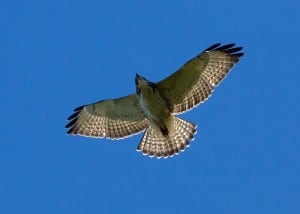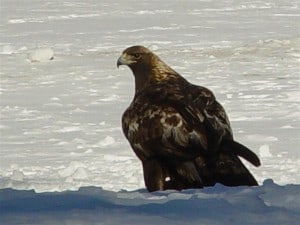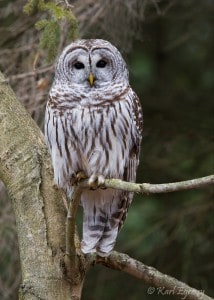With a little time on my hands each day between 10:00 pm and 2:00 pm, and with thanks to very cooperative weather, I have been sitting out in the field watching the fall raptor (and Monarch) migration. Despite good numbers of passing Broad-winged Hawks on Sunday the 14th, it appears that there may be fewer of that species to come, though there is still a trickle passing through The Kawarthas, and there still may be one more “big day” here for the species this season. Although I remain optimistic, I have my doubts that there will be many more to come this year. This is mostly because that over the 35 years that I have watched and counted raptors in the fall, the average date for huge Broad-winged Hawk flights over the Kawarthas and the Oak Ridges Moraine is September 15th, (and during most of those years, it has actually occured ON the 15th!)
With 216 Broad-wings seen on the 14th, (168 of them being seen all at once), I had spent relatively little time on that day staring at the sky watching for more, so I no doubt missed many hundreds more. This is another reason why I believe that the bulk of them may now have already pushed on. On the following day, I saw only 24 despite hours of watching for them. And, only 22 on the 16th, and none on the 17th. Not to worry however, as even though spectacular in their own right, (soaring sometimes in huge groups like they do), there are still many more species of raptors passing overhead on their way elsewhere, for a person to enjoy. Every day you can have expectations of seeing “something”, and once you know which species to expect throughout the changing season, it becomes enjoyably predictable for the most part. There are always fun exceptions, however.
So yesterday, (the 16th), I returned to the field for the “magic hour”, (which is actually two hours – 10:00 am to noon). At this time of day, most of the raptors are still low and easily visible, as the Earth is just warming up, and winds are light. At noon, however, many, if not most of the birds are quite high, and sometimes already too high to find easily with binoculars. This “noon-time-lull” can continue sometimes well into the afternoon, but if the weather changes, so do your chances of once again seeing more raptors. Some weather is simply great for migrating long distances, while other weather is more suited to staying put and foraging a meal.When such a change takes place, you will notice more of the hawks lower, and even coming down for something to eat on occasion.
The morning of the 16th began in a routine way, with little pulses of passing Turkey Vultures and Broad-wings, not yet too high to spot. Nothing special, but just a nice couple of hours of hawk watching. The Broad-winged Hawk tally for the day was close to the same for the previous day. I would say that on the 16th, the 2nd year bald eagle (still going through its summer moult with several new secondaries only half-grown out), was a highlight, as it soared with five vultures.
Tally for Sept. 16
Turkey Vulture – 20
Broad-winged Hawk – 22
Red-tailed Hawk – 5
Red-shouldered Hawk – 4 (including two resident adults)
Bald Eagle – 1
Sharp-shinned Hawk – 2
Merlin – 2
Today, (the 17th), I got seated in the field once again, by about 10:30 am. I had waited for some time, (counting passing Monarchs), and not much in the way of a raptor flight seemed to be happening.
The sky was different than it had been during the previous three days as well. Instead of the steady stream of roundish “poofy” cumulus moving from west to east through an otherwise blue sky as had been the case from Sunday through Tuesday, it was a rather mixed sky of cumulus, altocumulus, and cirrus to name a few. The wind too, was shifting back and forth from west to south-west, and didn`t have that cool little west-north-west snap to it that it had earlier in the week either. The breeze was somewhat warmer – not the best for Broad-wings, but made me wonder about vultures, red-tails, and eagles. These larger birds do seem to move well on inland south-west winds, and more so than other raptors, (based on personal obs.) Other than two immature red-tails, all I had seen were some vultures, and now it was just after noon.
I had just watched a Turkey Vulture soar way up and out of sight with an immature Red-tail, when I looked out over the woods to the north-east ofthe field at an approaching vulture. As I watched it through binoculars, I had a disgusting thought; “I wonder what it had for breakfast?” Made myself giggle a little, and also note that I myself, had not yet had any breakfast. Hmm, now feeling hungry, figured I should soon head inside for some edibles. Took one last look at the vulture, and “What`s that?” I thought. Well, in behind the soaring vulture and heading my way, was another bird. Large, “black”, and with deeply crooked wings as it just seemed to hold itself in the air, (though appeared to be getting larger). It was in fact coming in at quite a speed, though its great size combined with its speed, seemed somehow deceptive. Even though it likely didn`t come to within even 50 meters of the vulture, the vulture suddenly turned earthward, and with wings flapping, dropped perhaps 20 meters, and well out of the way of this descending beast. (I dad never seen a vulture do that before). Just prior to the “ducking” of the vulture, I had guessed “an eagle”, but not until it began to slice past south of me could I see clearly that it was an adult Golden Eagle with short, fat head, longish tail, and other than the small pale area of feet and undertail coverts, it was otherwise all dark underneath.
As it passed behind me I watched through binoculars as its true speed (well over 100 kph I am guessing with confidence) became apparent. It was obviously taking a break for lunch, (it was 12:15 pm after all). Just before its destination was reached, it banked sharply to the south, and in a much steeper contorted twist, passed directly over the large basswoods, maples and hickories that line the road, and the last I saw of it, the wings were pulled above the back and nearly closed, and the legs were extended with the feet spread far apart making it look like a letter “X” and then it had dropped out of my site. Within three seconds, a flock of close to forty Canada Geese, (among the usual fare for both Bald and Golden Eagles), took to the sky honking in alarm and headed fast, over to nearby Belmont Lake. (Where the eagle had disappeared to, there is a small pond surrounded by marsh, which is then in the middle of cow pasture. Next to that, there is a rather large crop field. From August through the rest of the fall, many waterfowl use that spot, and often in the evening you can watch them going down into the pond in fair numbers.)
I waited a full ten minutes, thinking that if the eagle had missed its intended catch, then it may soon come back up to soar, and it just might come back my way and allow me to take a photo, (which I would never have obtained when it had stooped past me. It was too fast to even bother trying!) Well, after the ten minutes or so had passed, I could still hear the agitated crows in the direction that I had last seen the eagle. So, I jumped in the car and drove over near there. I parked on a road allowance right-of-way, and walked along it for a while until I finally located the crows not far away. They were perched in the dead top of a large willow, and although they were still “talking”, they were not saying much. That is to be expected however, and as I watched them, I could see that they would often look down, and further west, (and away from me), and down behind the trees upon which they perched. So, I believed that the eagle had been successful, was down on the ground with its catch, and the crows were watching it, but my view of it was blocked by these trees. I walked on a little further, and when I came out fully into the view of the crows, they flew across a section of the pasture, and came to land in the tops of pines on the other side. I checked them with binoculars, and a few were looking down, now in between where they were, and where they had been. I am pretty sure that the eagle was down in there somewhere, and they were still keeping their keen eyes on it. I walked back to the car, and returned home.
I went back out and sat in the field, watching over that way. I knew that if the eagle had made a catch, that it would take it about an hour to gorge, clean and preen itself, and that if I waited at least that long, I may see it come up once again, and ideally, soar over me for a photo. The more likely scenario though, would be that after the “eat lunch and tidy up” routine, the bird would simply go and sit in some lofty pine, and maybe not even move again during the same day. Or still, it may just drift off in some other direction that didn’t include one more pass over me. I never saw it again. Either way, I`m glad for what I did see of it! Strange perhaps, but I have seen very few Goldens in September, and don`t even recall the last time that I did. They tend to move through here in October, (latter half of the month for the most part), and early November. Some certainly winter here in the Kawarthas each year. Again in March and April, it`s not uncommon to spot the odd one on its spring migration.
Interesting too, is that it was an adult. Only about 1 in 10 that I see are in complete adult plumage. The only one I saw last winter however, (three times in the same area), was also an adult.
As the whole thing unfolded today, I had somewhat of a “deja vu” moment, as it was just the night before that I watched The Nature Of Things, and part of the program was footage of Golden Eagles hunting young mountain goats. Well, photos or no photos, I am much happier seeing it all in the real world, the natural world. (Better than TV.) Gives even more meaning to “outside the box”. In the 1980s and `90s, I worked for a commercial falconer, and for two decades I was also a raptor bander with the Toronto Bird Observatory. As exciting as all that was, seeing the trained hawks, eagles and falcons do “their thing”, and capturing and banding hundreds of wild birds of prey with TBO, it pales by comparison to the raw and “without human influence” experiences of days like today with the eagle, (and of two weeks ago with a similar witnessing of the normal, and daily life of a Peregrine).
Not to hype the rare, (just mentioned because they are recent), I do enjoy the moments with the “common” birds too, like watching an American Kestrel hold and devour a grasshopper while hovering on a stiff breeze, seeing a Merlin snatch a bat from the air when it`s so dark out that the first stars of evening are already visible, or crouching while a nearby Barred Owl walks a shallow creek digging out crayfish from beneath debris on the creek floor. It`s all good!!!
Tally for Sept. 17
Turkey Vulture – 32
Red-tailed Hawk – 2
Sharp-shinned Hawk – 1
Merlin – 1
Golden Eagle – 1
Tim Dyson, Cordova Lake


